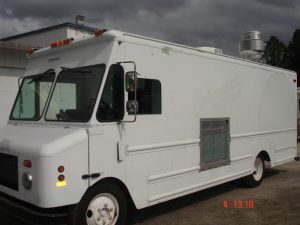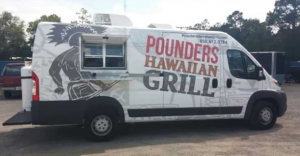Unfortunately, food trucks can be prime targets for thieves, cash-heavy operations often parked in unsecured locations with little oversight. This underscores just how critical it is to prioritize safety for your mobile business and take proactive steps to shield it from theft and damage.
Fortunately, implementing effective security measures doesn’t have to be complicated. With consistent habits and smart design choices rooted in food truck manufacturing expertise, you can significantly reduce risks to your mobile kitchen. Below, we’ll cover the essentials and dive into specialized tactics to keep your investment secure.
The Basics
Some precautions are so fundamental they almost go without saying, yet they’re worth repeating because they’re non-negotiable. Build these into a daily checklist for closing down your truck, and if you don’t already have one, create it now.
Always lock all doors, front cab and rear entry, and take your keys with you. A surprising number of stolen trucks are nabbed simply because the keys were left inside or nearby. Speaking of keys, resist the urge to stash a spare set anywhere on or near the truck. Thieves know the usual hiding spots, like under mats or in wheel wells. If you need a backup, store it safely at home, on your person, or in a secure off-site location no one could stumble across.
Next, conceal anything valuable from prying eyes. Cash registers, laptops, or even branded gear, hide them deeper inside the truck or, better yet, take them with you. The less visible temptation, the better. Most crucially, never leave your truck’s Registration or Title inside. Thieves can use these documents to fraudulently sell your vehicle, turning a bad situation into a nightmare. As a manufacturer, I recommend integrating lockable interior storage compartments, crafted from 16-gauge stainless steel, into your truck’s design. These can be welded beneath counters or behind panels, keeping valuables out of sight and secure.

Protect your food truck from bad guys like this.
Location, Location, Location
Where you park your food truck overnight can make or break its safety. Whenever possible, store it inside a locked building, be it your home garage, a rented storage unit, or a shared commissary kitchen. In some cities, regulations mandate parking in secure commissaries, solving the problem for you. If that’s not an option, scout a spot yourself. Thieves tend to target trucks in open, accessible areas, so a locked indoor space adds a formidable barrier. For trucks built with overhead clearance in mind, like those on a Ford F-550 chassis with a 12-foot height, ensure your garage or storage facility accommodates the extra height to avoid structural damage.
If indoor parking isn’t feasible, choose an outdoor spot wisely. Opt for a well-lit area, ideally near your home or business, and out of casual sightlines. Equip your truck with exterior LED floodlights, wired into a timer or motion sensor system. These are standard options in modern food truck builds, drawing power from a rooftop solar panel or auxiliary battery, and they double as a theft deterrent when left on after hours. Adding a visible camera, real or fake, can further discourage would-be thieves, signaling that the truck is monitored. I often recommend mounting a dummy camera housing, painted in high-visibility yellow, above the service window for maximum effect.
Lock It Down
Make your truck a tough target even when parked. Turn the wheels sharply to one side and position the drive axle, front or rear depending on your truck, against a wall or immovable object. This complicates towing attempts, forcing the wheels to drag awkwardly and slowing thieves down, possibly enough for you to intervene. For heavier-duty models, like those built on a Chevrolet LCF 4500 chassis with a GVWR of 16,000 lbs., the sheer weight already acts as a deterrent, but proper positioning amplifies this advantage.
But theft isn’t just about the truck itself. Generators, tires, and internal equipment are ripe for the picking too. Secure your generator with a heavy-duty hatch lock, ideally a 1-inch-thick steel plate with a puck lock system, custom-fabricated into the truck’s exterior compartment. Use specialty tamper-proof lug nuts, like those with a unique key pattern, to prevent tire theft. Bolt down anything you can’t take with you, such as a 60-inch griddle or refrigeration unit, using 3/8-inch stainless steel bolts anchored into the truck’s reinforced floor frame. For smaller items left onboard, consider a hidden safe welded to the chassis, constructed from 14-gauge steel with a digital keypad for quick access.
Cash management is another key layer. Split your money into two batches: one for daily use, kept in a secure spot between shifts, and another collected off-site for bank deposits. On high-volume days, arrange for a trusted employee or courier to pick up excess cash mid-shift or just before closing. This minimizes losses if a theft occurs overnight. From a design perspective, I suggest integrating a drop-safe system beneath the counter, accessible only via a trapdoor with a biometric lock, tailored to high-traffic food truck layouts.

Security
Even with preventive measures, determined thieves might still try their luck. That’s where robust security systems come in. Install a vehicle alarm system, ideally one linked to a security company that responds instantly when triggered. Too often, random car alarms are ignored as false alerts, so opt for a system with a 120-decibel siren and cellular connectivity.
For extra protection, add ignition or fuel cut-off switches. These ensure the truck won’t start without your authorization, thwarting drive-away attempts. In manufacturing, I often wire these into the truck’s electrical system, hidden behind a false panel in the cab for seamless integration.
If high-tech switches stretch your budget, mechanical locks offer a solid alternative. Beyond steering wheel locks, consider a transmission lock or a wheel boot, similar to those used by parking enforcement. For a 26-foot food truck built on a Freightliner MT55 base, a heavy-duty wheel boot rated for 10 tons adds serious staying power. Applying one or more of these nightly transforms your truck into an immovable fortress.

Hawaiian Food Truck Built by M&R Specialty Trailers and Trucks
Expert-Designed Theft and Damage Protection
As a food truck manufacturing expert, I’ve seen firsthand how design can elevate security. Here are specialized features and tactics to protect your mobile kitchen from theft and damage:
Reinforced Exterior Panels: Upgrade your truck’s skin to 1/8-inch aluminum or composite panels with a diamond-plate finish. These resist pry attempts and dents from vandalism, unlike standard 1/16-inch cladding, and add minimal weight to a Sprinter van or Isuzu NPR chassis.
GPS Tracking with Geofencing: Install a discreet GPS tracker, like a hardwired Teltonika FMB920, with real-time alerts. Set up a geofence, a virtual boundary around your parking spot, and get notified instantly if the truck moves outside it. Pair this with a remote engine kill switch, a feature I integrate into the wiring harness during assembly, to stop thieves cold.
Anti-Slip Flooring with Drainage: Protect against internal damage from spills or break-ins by installing marine-grade, non-slip vinyl flooring with built-in drainage channels. This prevents water pooling if a window is smashed and simplifies cleanup, a detail often overlooked in basic builds.
Shatterproof Windows: Replace standard glass service windows with 1/4-inch polycarbonate panels, rated to withstand hammer blows. These are lightweight, UV-resistant, and standard in my high-security builds, ensuring thieves can’t easily smash their way in.
Hidden Backup Battery: Power your security systems with a secondary lithium-ion battery, tucked into a locked compartment beneath the driver’s seat. Wired to alarms and lights, it kicks in if the main battery is tampered with, a safeguard I’ve designed into trucks for off-grid operators.
Final Thoughts
You don’t need to implement every tactic here, overdoing it could drain your time and budget. Start with the essentials: lock up, hide valuables, park smartly, and secure the basics. Then layer on a few extras that fit your needs, whether that’s a wheel boot or a GPS tracker with remote shutdown. With decades of experience building food trucks, I can assure you that combining smart habits with purpose-built design features will keep your mobile kitchen safe from theft and damage. That way, you’ll wake up each morning ready to serve customers, not chasing down your missing truck!

Leave A Comment